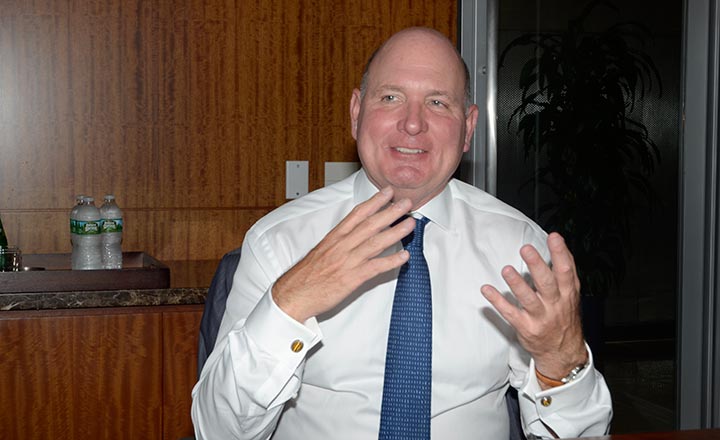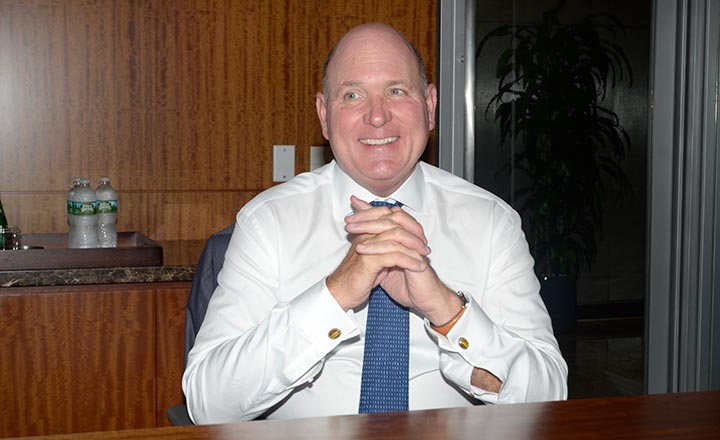Lever House on Park Avenue is a New York City landmark that plays host to the office of Jaguar Growth Partners. As the name suggests, it was originally built in 1952 to house the American headquarters of Lever Brothers, the erstwhile avatar of present-day Anglo-Dutch consumer goods giant, Unilever. Jaguar’s co-founder Gary Garrabrant was a real estate investment banker before he embarked on a career in international real estate investing. Garrabrant’s mentor in the business was his uncle but Garrabrant was first drawn to real estate during his college days through a visiting professor who was a full-time real estate investor. Jaguar’s primary focus is emerging markets and its $350 million first fund has been fully deployed in Latin America. Jaguar is contemplating opening an office in Singapore to oversee its investments in Asia and in this interview with N Mahalakshmi and Rajesh Padmashali, Garrabrant outlines why he is bullish on India and the pockets where he sees opportunity.
Amid this low growth, low inflation period, people are talking about political risk in the United States. Does that change your investing approach or outlook towards emerging markets in any manner?
Global investors’ today talk about political risk in the United States — that is something that I have never heard in my lifetime. We associate political risk with other countries, but not with the United States. That’s a reality now and there is a cost associated with it, which is time and productivity. Therefore, a shift is taking place in the developed as well as the developing world.
Our focus is growth markets globally. We like to invest in markets that are out of favour. For instance, we were opportunistic and invested in Mexico despite all this rhetoric like the Wall, Border Tax, etc. which is not likely to happen, at least not as advertised. We have also invested in Latin America, and see it as having a bright future and want to increase our exposure. There aren’t too many people doing what we are doing.
What makes you bullish about these markets and also about India? What is it that you understand about these markets that the rest don’t?
We are extremely sensitive to which market is attracting support from institutional investors and has an entrepreneurial foundation. We are excited about the growth of the middle class, and adjunct to that is the large segment of youth and their increasing aspirations. They are driven by this desire to work hard, get a good job, rent an apartment, buy a house, buy a car, have children — all of which creates demand for all sorts of things. Real estate is the most effective way to capture the growth of the middle class.
As for India, if you look at the group of investors that it has attracted, we are now in the Sovereign Wealth wave. These funds do a lot of work before entering, and once they are established, they do not leave for a long time, unlike the opportunistic investors who leave fairly quickly. We look for signs like that.
We call ourselves institutional entrepreneurs and are there early, if not first. Our time horizon is three to 10 years and we look at things top-down in terms of what’s the aspiration of the country’s leadership, the rule of law, the culture beyond the rule of law and business culture in terms of partnering, institutional financing and respect for property rights. Once those boxes are ticked, we do the work to see which sectors are the most underserved. We look at the growth potential and find the right partners. We shy away from the frontier; we don’t like to get too far out. We made that mistake in our early years, now we don’t do that.
You always work with local partners…
We would never enter a market without strong local partners. If the partners don’t exist, we don’t get involved, and this approach has kept us out of trouble. We spend the most time evaluating partners, not projects. I was in the banking business earlier, specialising in accounting, tax and so on, building a global network. That’s our edge and we won’t ever compromise in getting the highest quality partners. In the process, we ourselves have learnt to be good partners.
You’ve said in an earlier interaction that it was a struggle for you to find partners in India…
It took us 15 years to find our first partner in India. Partly, that is a reflection of the complexity and scale of the country. India is sort of misleading as I have learnt — it is smaller than it appears. It’s all about just four or five cities, and that is India. It is an urban idea, and I am using the word generously as ‘urban’ in India has a very different meaning. Logically, it should be across geographies and more sectors, but it has not been like that yet.
In real estate, we are now beginning to see a shift from the ‘promotional’ way — I smile every time someone says the word ‘promoter’ — to a much more professional class. This is happening, not just in real estate, but across several industries. Blackstone has done a wonderful job of buying a lot of office buildings and creating a large office business. Ditto for Brookfield and QIA. That’s terrific, but there should be more. Even in retail, it has been complicated. There is great political pressure, so local retailers are favoured over international retailers. There isn’t any long-term capital available to support integrated ownership and it tends to be fractionalised; that then resulting in poorly maintained structures. It also shows up in the office sector.
With GST, logistics properties should be a big business. Rental housing could be a big play too. I will never forget visiting one of the campuses in Hyderabad. We went into the garage, there were no cars; it was all motorcycles and scooters. When we toured the building it was full of young people, so this rental idea married to urbanisation suggests there is a big play in rental housing.

Can India miss the offline retail story completely, like we have leapfrogged from no phones to mobile phones? Does the case for retail become weaker with the advent and accelerated adoption of online and high real estate prices?
Retail is struggling and trying to find itself everywhere. In the US, suburban malls that are not regarded as iconic or top are struggling. That is a function of the e-commerce impact, where people are extremely comfortable, people in India even more so. India has missed this period that existed in the United States, of the mall, which started in the 1960s and continued for 35 years. That period may not be replicated but there are other models. I was in Hamburg and looked at a mall that has kept evolving. The mall went from several large department stores to none. What’s there now? H&M, Zara and a few other small and large format stores and the mall itself became the department store. There are three food stores and in Europe people like buying food for the day. The mall was packed and people were freely shopping between perishable and non-perishable goods unlike most malls here in the United States, which tend to be one or the other. If retail is going to survive, Brazil is another example where it actually thrives because they are urban town centers where people go, to be seen and to see. There are parallels with Brazil where climate control is actually an attraction and security is an attraction too. There is also the socialisation and I see that in India too. Retail is complicated, there is no question about that and maybe it isn’t such a big opportunity.
You said the market is much smaller than it seems or big in pockets. Now that India has everybody’s attention, could it lead to overheating?
It can be very precarious. The idea is more compelling than the reality and that is the Indian property market today. Institutional capital has arrived, but there has to be greater professionalisation of the real estate industry, not just the owner-operator selling something but institutional ownership of buildings. That’s going to be an exciting ramp for India, because of the impact of Blackstone, Brookfield, QIA etc. The big banks like ICICI and HDFC can make longer-term capital available, away from lending to the promoter-developer, where the game is all about the completion of a building, as opposed to creating value over several decades.
There is a German investor Otto Group whose investment company Paramount acquired buildings in mid-town Manhattan in the 1970s when New York was bankrupt. Those buildings are worth billions of dollars now. One of the buildings that they acquired for $70 million is now $2 billion in value. That’s long term capital. That’s what India should have, and that’s the big opportunity. We are entering via a housing finance venture with an existing bank because it is appropriate at this moment. It’s not a new idea or product but it’s the beginning of our presence in India. That said, when there is too much interest, bad things can happen. India has been problematic; a lot of people have done very poorly. Just like Brazil. India is not distinguished in that way!

Along with housing finance, what kind of opportunities do you see in rentals?
The rental housing model is logical but it requires financing as the return is never high enough. Rental housing thrives when there is long-term debt available; America is a shining example of that. In India, however, the yields are unsustainable. That has to change. There has to be a yield that works and diversity in the products available. For example, in Latin America, there isn’t large scale professionalised rental housing. That’s also true of India probably, where you don’t have low-rise, mid-rise and high-rise, with various physical characteristics and differentiation, for which people are willing to pay. As the capital market becomes more mature, one would hope that there would be supply of longer-term capital, and you’ll have the option of buying or renting. But the yields have to work, it can’t be subsidised.
Affordable housing is yet another opportunity, which is a bigger idea. Historically, we were involved in the creation of the largest home-builders in both Mexico and Brazil. But that again requires professional management, as the idea is not developers manufacturing and selling housing units. It is about building communities with thousands of units with all kinds of facilities like schooling, medical, employment opportunities and so on. As economic growth and drivers of employment diversify, there are better and better jobs and that employment gives people the capacity to live better. Urbanisation has already been socialised in India as opposed to China where there is a lot of stress that goes with people leaving rural, agricultural settings into urban environments for the first time.
Those micro-factors of course have to fall in place but the larger question is the macro itself is not conducive to a rental model. If you are to survive at 3% rental yields in India, you should be able to source capital at 0%...
These projects can’t get done at these yields. No one can make money at these yields. The rents have to rise, but rent will rise only when a better product is available. Right now those products are not available. We are in a global phase where it appears that both global growth and inflation will remain subdued in the foreseeable future, and we are in a phase where the ageing in developed markets are starved for income. People did not underwrite their retirement at 2% return. The elderly in United States are not happy, and with healthcare advancement, they are living longer. So for individual investors in United States, the yield does not exist today. That’s where India can be a source of that yield. But that yield can’t be 3% in rupee terms. 15% in rupee is sustainable. Dollarise that, and it is 12%, that’s sustainable, and that’s appropriate for the risk. So what should be the return for professionalised rental housing? High single digits: that is what it should be. A lot of people in this country will buy those bonds for that kind of yield.











